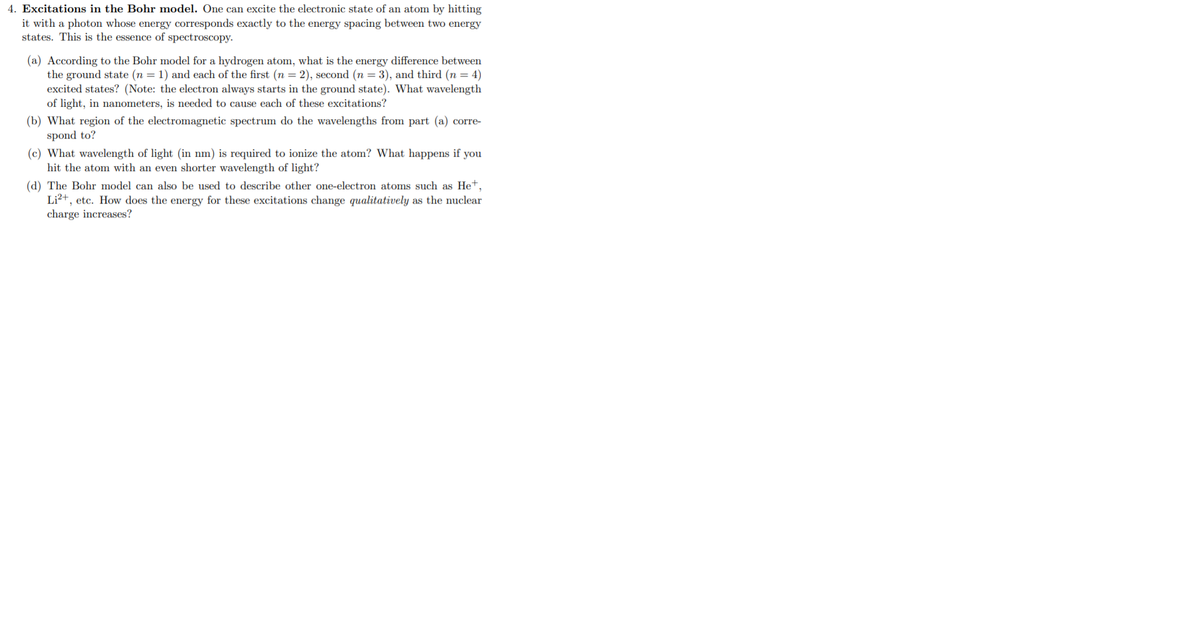1. Excitations in the Bohr model. One can excite the electronic state of an atom by hitting it with a photon whose energy corresponds exactly to the energy spacing between two energy states. This is the essence of spectroscopy. (a) According to the Bohr model for a hydrogen atom, what is the energy difference between the ground state (n = 1) and each of the first (n = 2), second (n = 3), and third (n = 4) excited states? (Note: the electron always starts in the ground state). What wavelength of light, in nanometers, is needed to cause each of these excitations? (b) What region of the electromagnetic spectrum do the wavelengths from part (a) corre- spond to? (c) What wavelength of light (in nm) is required to ionize the atom? What happens if you hit the atom with an even shorter wavelength of light? (d) The Bohr model can also be used to describe other one-electron atoms such as He*, Li?+, etc. How does the energy for these excitations change qualitatively as the nuclear charge increases?
1. Excitations in the Bohr model. One can excite the electronic state of an atom by hitting it with a photon whose energy corresponds exactly to the energy spacing between two energy states. This is the essence of spectroscopy. (a) According to the Bohr model for a hydrogen atom, what is the energy difference between the ground state (n = 1) and each of the first (n = 2), second (n = 3), and third (n = 4) excited states? (Note: the electron always starts in the ground state). What wavelength of light, in nanometers, is needed to cause each of these excitations? (b) What region of the electromagnetic spectrum do the wavelengths from part (a) corre- spond to? (c) What wavelength of light (in nm) is required to ionize the atom? What happens if you hit the atom with an even shorter wavelength of light? (d) The Bohr model can also be used to describe other one-electron atoms such as He*, Li?+, etc. How does the energy for these excitations change qualitatively as the nuclear charge increases?
Principles of Modern Chemistry
8th Edition
ISBN:9781305079113
Author:David W. Oxtoby, H. Pat Gillis, Laurie J. Butler
Publisher:David W. Oxtoby, H. Pat Gillis, Laurie J. Butler
Chapter4: Introduction To Quantum Mechanics
Section: Chapter Questions
Problem 39P: Chapter 3 introduced the concept of a double bond between carbon atoms, represented by C=C , with a...
Related questions
Question

Transcribed Image Text:4. Excitations in the Bohr model. One can excite the electronic state of an atom by hitting
it with a photon whose energy corresponds exactly to the energy spacing between two energy
states. This is the essence of spectroscopy.
(a) According to the Bohr model for a hydrogen atom, what is the energy difference between
the ground state (n = 1) and each of the first (n = 2), second (n = 3), and third (n = 4)
excited states? (Note: the electron always starts in the ground state). What wavelength
of light, in nanometers, is needed to cause each of these excitations?
(b) What region of the electromagnetic spectrum do the wavelengths from part (a) corre-
spond to?
(c) What wavelength of light (in nm) is required to ionize the atom? What happens if you
hit the atom with an even shorter wavelength of light?
(d) The Bohr model can also be used to describe other one-electron atoms such as He+,
Li2+, etc. How does the energy for these excitations change qualitatively as the nuclear
charge increases?
Expert Solution
This question has been solved!
Explore an expertly crafted, step-by-step solution for a thorough understanding of key concepts.
This is a popular solution!
Trending now
This is a popular solution!
Step by step
Solved in 3 steps

Knowledge Booster
Learn more about
Need a deep-dive on the concept behind this application? Look no further. Learn more about this topic, chemistry and related others by exploring similar questions and additional content below.Recommended textbooks for you

Principles of Modern Chemistry
Chemistry
ISBN:
9781305079113
Author:
David W. Oxtoby, H. Pat Gillis, Laurie J. Butler
Publisher:
Cengage Learning

Principles of Instrumental Analysis
Chemistry
ISBN:
9781305577213
Author:
Douglas A. Skoog, F. James Holler, Stanley R. Crouch
Publisher:
Cengage Learning

Chemistry for Engineering Students
Chemistry
ISBN:
9781337398909
Author:
Lawrence S. Brown, Tom Holme
Publisher:
Cengage Learning

Principles of Modern Chemistry
Chemistry
ISBN:
9781305079113
Author:
David W. Oxtoby, H. Pat Gillis, Laurie J. Butler
Publisher:
Cengage Learning

Principles of Instrumental Analysis
Chemistry
ISBN:
9781305577213
Author:
Douglas A. Skoog, F. James Holler, Stanley R. Crouch
Publisher:
Cengage Learning

Chemistry for Engineering Students
Chemistry
ISBN:
9781337398909
Author:
Lawrence S. Brown, Tom Holme
Publisher:
Cengage Learning

Introductory Chemistry: An Active Learning Approa…
Chemistry
ISBN:
9781305079250
Author:
Mark S. Cracolice, Ed Peters
Publisher:
Cengage Learning

Chemistry: Principles and Practice
Chemistry
ISBN:
9780534420123
Author:
Daniel L. Reger, Scott R. Goode, David W. Ball, Edward Mercer
Publisher:
Cengage Learning

Physical Chemistry
Chemistry
ISBN:
9781133958437
Author:
Ball, David W. (david Warren), BAER, Tomas
Publisher:
Wadsworth Cengage Learning,